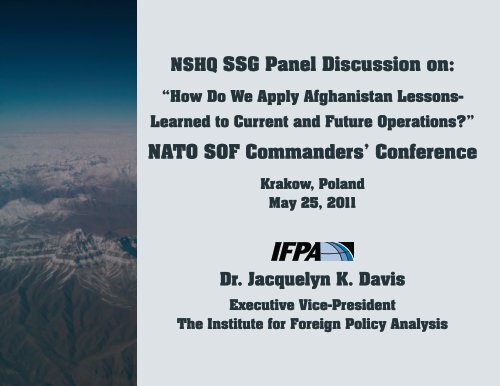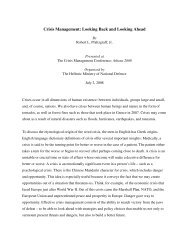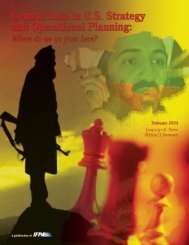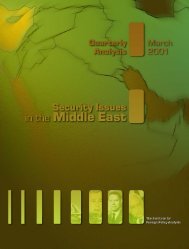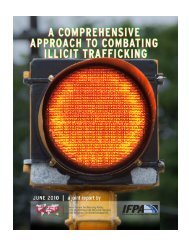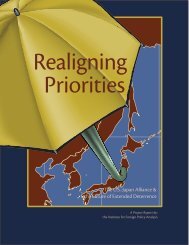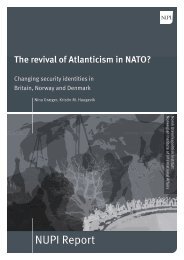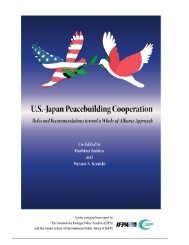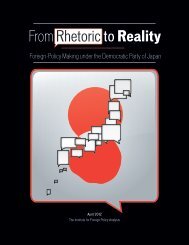slides - Institute for Foreign Policy Analysis
slides - Institute for Foreign Policy Analysis
slides - Institute for Foreign Policy Analysis
- No tags were found...
Create successful ePaper yourself
Turn your PDF publications into a flip-book with our unique Google optimized e-Paper software.
NSHQ SSG Panel Discussion on:<br />
“How Do We Apply Afghanistan Lessons-<br />
Learned to Current and Future Operations”<br />
NATO SOF Commanders’ Conference<br />
Krakow, Poland<br />
May 25, 2011<br />
Dr. Jacquelyn K. Davis<br />
Executive Vice-President<br />
The <strong>Institute</strong> <strong>for</strong> <strong>Foreign</strong> <strong>Policy</strong> <strong>Analysis</strong>
NATO’s New Strategic Concept —<br />
“Active Engagement, Modern Defense”<br />
NATO SOF Core Missions (i.e., Military Assistance (MA), Special<br />
Reconnaissance (SR), Direct Action (DA)) provide solid basis <strong>for</strong> future<br />
NATO planning with respect to:<br />
Contingencies and Mission Taskings calling <strong>for</strong> Legacy Skills and New<br />
Core Competencies within the context of<br />
Article-5 Collective Defense Missions<br />
Iran<br />
Russia<br />
New Taskings derived from Article-4 Crisis Consultations<br />
C-WMD<br />
CT/COIN<br />
CP/Illicit Trafficking<br />
Cooperative Security<br />
Building Partner Capacities<br />
Training of NATO and Partner SOF and Other (e.g. Police) Forces<br />
Building Relationships to Support the Comprehensive Approach<br />
EU<br />
NGOs<br />
IGOs
NATO SOF and Preventive Planning<br />
Pre-Crisis or Pre-Conflict Planning is Central to NATO’s NSC<br />
NATO SOF Can Facilitate and Leverage Comprehensive Approach<br />
MA missions enhance capacity building in and outside of NATO<br />
SOFFC promotes situational awareness and in<strong>for</strong>mation-sharing<br />
The NSHQ and its Deployable Component Command (SOCC)<br />
element offer SACEUR and SAC-T enormous potential:<br />
For New Mission Taskings (e.g., Counter-WMD, with NATO’s<br />
Combined Joint Chemical Biological Radiological and Nuclear<br />
Defense Task Force)<br />
As a Basis <strong>for</strong> NATO/non-NATO Partner Collaboration<br />
In Conjunction with NRF Force Generation and Crisis Deployments<br />
And, with respect to Training and Education
SOF Lessons-Learned from Current Operations<br />
Afghanistan<br />
Flexibility and Agility of SOF to Tailor CT/COIN Strategies<br />
NATO SOF are Essential to ISAF’s Exit Strategy<br />
Partner Relations are Key to Operational Success<br />
Within NATO<br />
Global Partners<br />
NGOs and IGOs<br />
Paradigm Shift between Supported and Supporting Agencies/<br />
Forces<br />
BICES/MESH<br />
SOFFC<br />
And, with Libya<br />
Enablers<br />
Mobility
Into the Future<br />
NATO SOF Storyboard<br />
Change Existing Perceptions of SOF (e.g., Capabilities and Gaps,<br />
Legacy Spetsnaz)<br />
Differentiate from Conventional Forces (i.e., Where and How do<br />
SOF Fit)<br />
Optimize SOF Roles in New Mission Areas with Respect to:<br />
Collective Defense<br />
Crisis Management<br />
Cooperative Security<br />
“Smart Defense” and Pooling of NATO SOF Aviation-Relevant Assets<br />
Creation of a Dedicated NATO SOF Air Component<br />
Establishment of a NATO SOF Air Education Program<br />
NSHQ is a SOF Force Multiplier and Catalyst <strong>for</strong> Operationalizing<br />
NATO’s Comprehensive Approach


